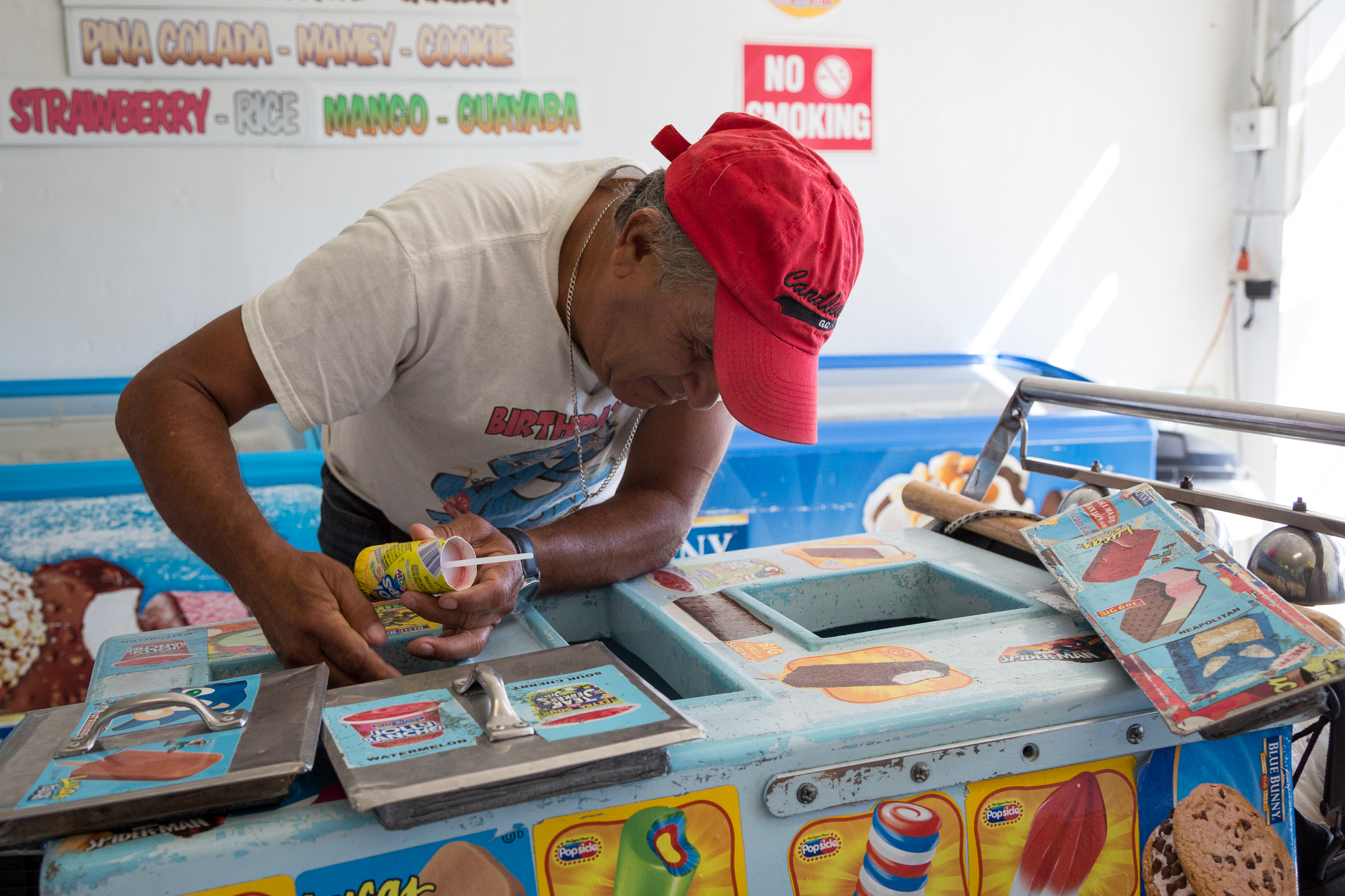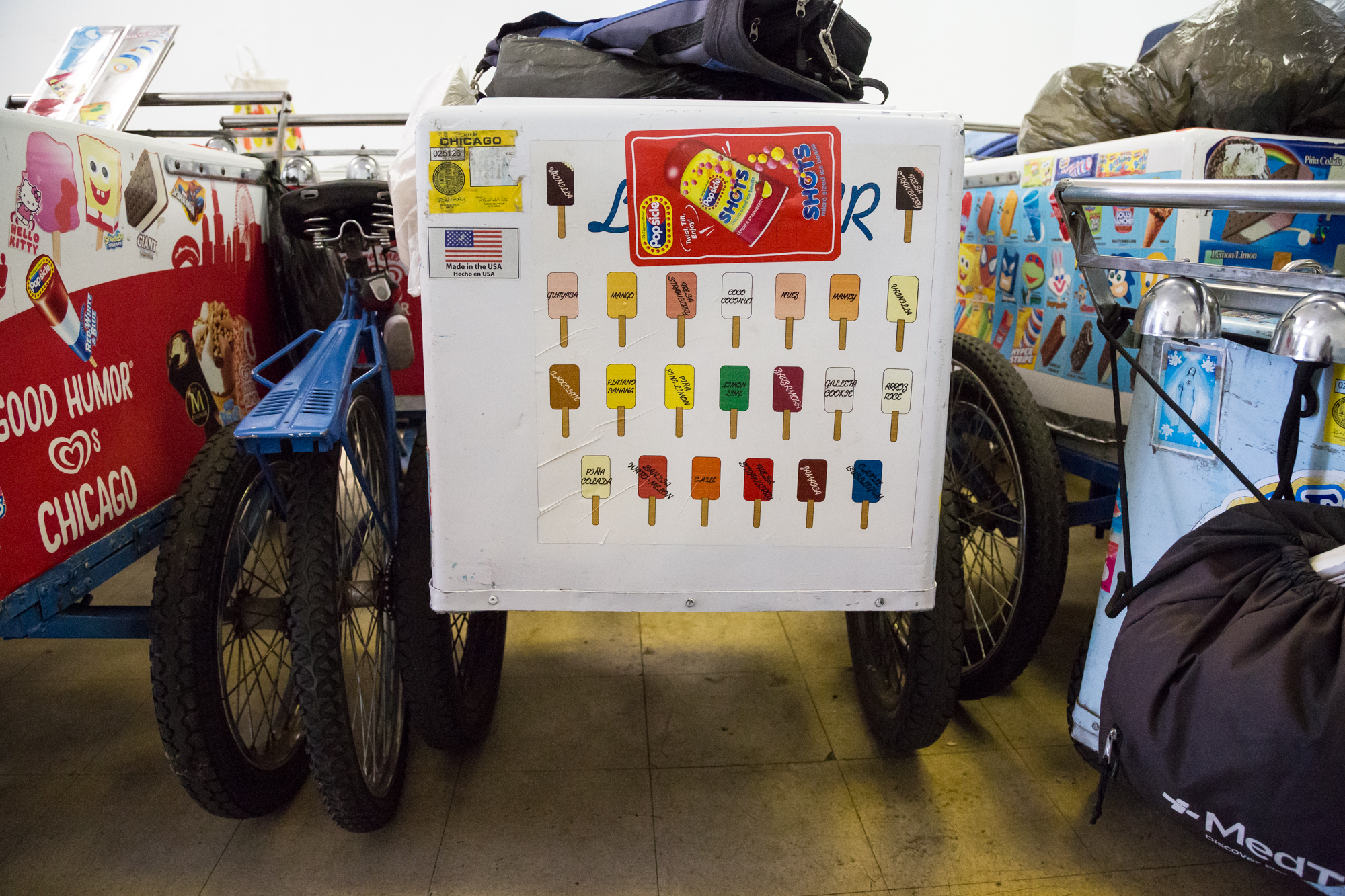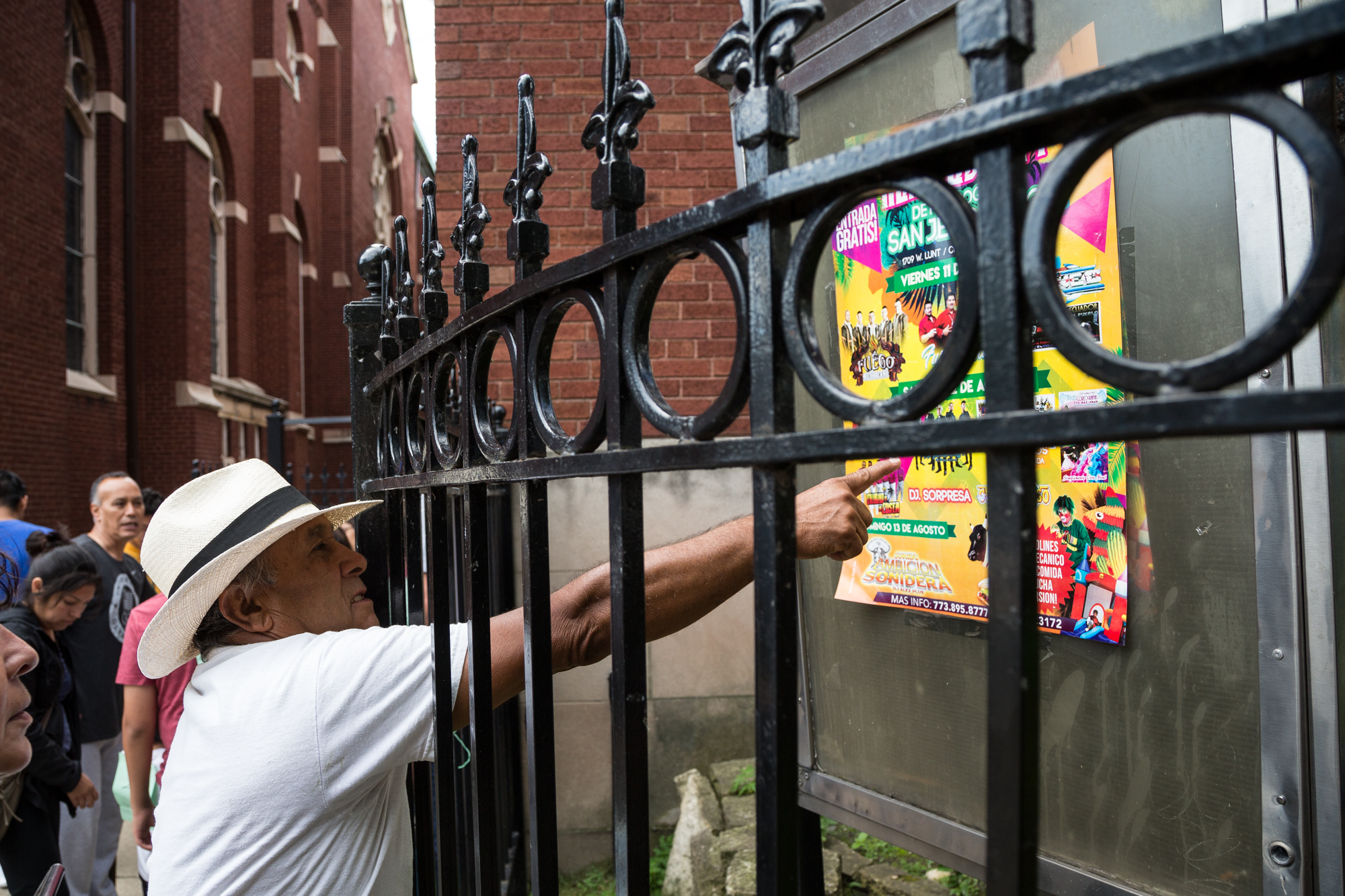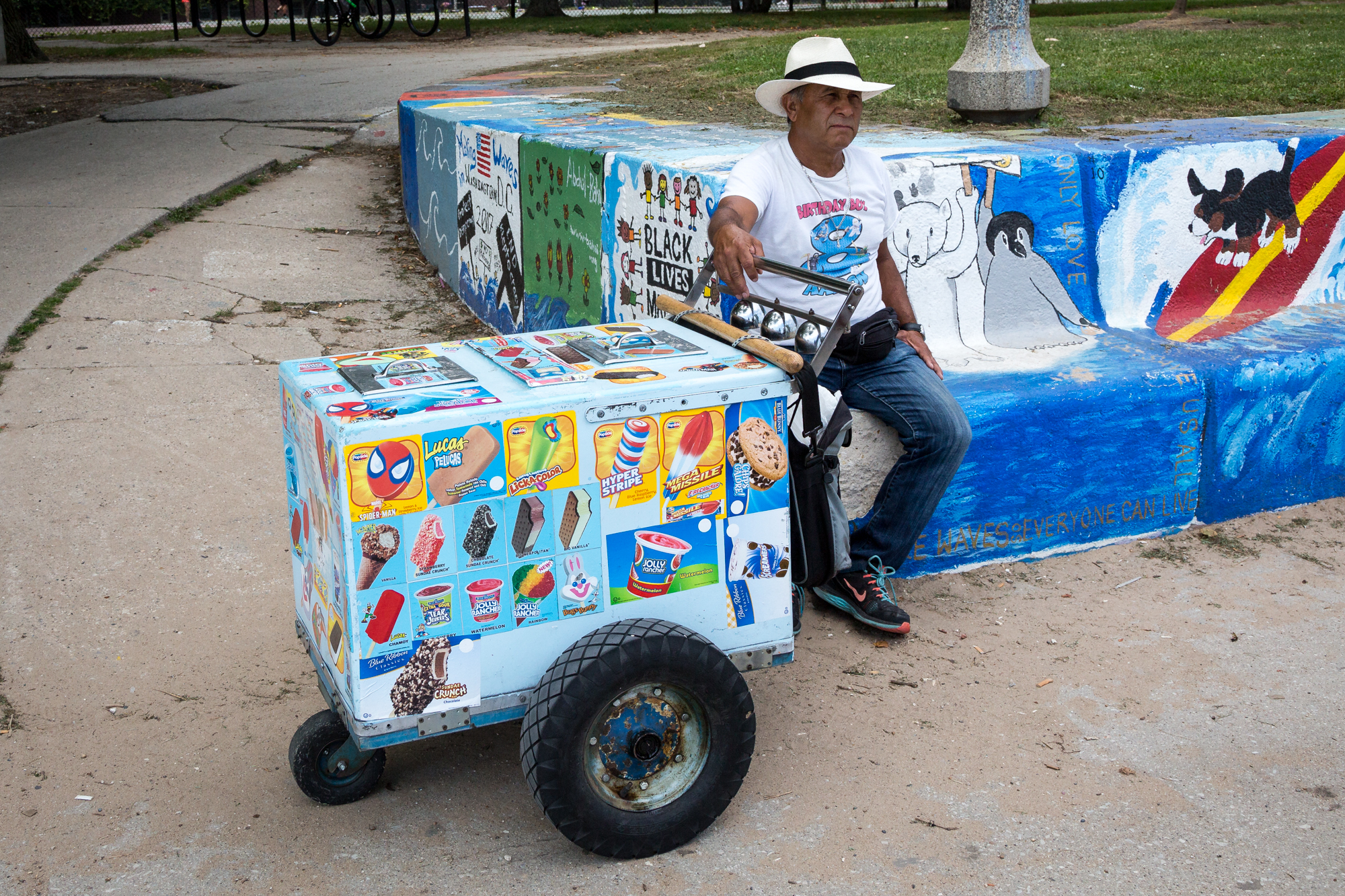Editor's Note: The podcast episode that appears with this article was published in July 2021, as an update of an episode that originally appeared in 2017.
It’s that season when the bells from ice-cream carts can be heard across the city, from Chicago sidewalks to parks and beaches. It’s also the time of year when we get asked about Mexican popsicles, also known as paletasin Spanish, and the paleteros who sell them.
So, we were delighted to take on this question from Samuel Osorio: How do you get a job selling ice cream from a rolling cart? And where do you have to go? Maybe Samuel was just curious, or perhaps he’s considering working as a paletero — we couldn’t reach him to find out.
The paleta business began in the 1940s in the city of Tocumbo, Michoacán in Mexico (which has a large paleta statue to celebrate the frozen treat). Tocumbians Ignacio Alcazar and Agustin Andrade introducedpaletas to Mexico City in the 1940s, and the ice pops eventually made their way to Chicago.
Today, paletasare a summer staple in the city. We’re going to lay out what you need to know to be a paletero — from the relationship between suppliers and vendors to choosing the right mix of flavors to attract a diverse clientele. The spoiler: For so-called less-skilled work, being a paletero takes a lot of strategy and savvy.
The business relationship
To get the Chicago scoop (pun intended), Curious City headed to La Polar, a small ice cream and paleta shop on Clark Street in the Rogers Park neighborhood. Run by the Garcia family, La Polar is just one of many shops around the city that stock the paletassold by paleteros. It’s been in business on Clark Street for 17 years. The family owns another store on West Diversey Avenue, which they opened nearly 30 years ago. La Polar’s paletas are made at the Diversey Avenue location from fresh and frozen ingredients that come from both the United States and Mexico.
The Garcias rely on a small group of paleteros to sell their frozen treats throughout Chicago. Paleterosgenerally arrive early in the morning to load both pushcarts and bike carts with the frozen treat. Most of the carts are made in Mexico, but La Polar has also purchased carts from as far as Brazil, says Enrique Garcia, the owner of La Polar.

His daughter Paola has grown up around the business and knows what’s it’s like to push a rolling cart around the city. She’s done it more than once. She says most of the paleteros working for La Polar have other jobs and sell the frozen treats as a way to make extra money in the summer. They often get the job through the recommendations of family and friends. So, someone knows someone, who can put in a good word. La Polar has quite a few Latino paleteros but they also work with Middle Easterners who they’ve gotten to know through people in the Rogers Park neighborhood.
Garcia explains that La Polar loans both the carts and the frozen treats to the paleteros. The shop keeps track of exactly what goes into a paletero’s cart, and all unsold items are returned to the store at the end of each day. La Polar also obtains permits for the carts so that paleteros can sell on the lakefront and at restricted events — like parades — as necessary. There’s no hourly wage and earnings vary depending on how much they sell — both the store and the paleteros keep a cut of paleta sales.
As Garcia puts it:“Basically, they’re their own bosses.”
You decide when, where and how much
While La Polar provides paleteroswith a cart and a stash of paletas, the rest is really up to the vendors. That means on days when the weather is cloudy, fewer paleterosmight show up for work. It also means that since business tends to be busier on weekends, a greater number of paleteros head to La Polar on Saturdays and Sundays. Sunny days and large events, like the Chicago Pride Parade, will bring paleteros to the store as early as 7 a.m., Garcia says. But ultimately, the paleteros decide how many hours to work.
La Polar can’t entirely predict how many paleterosmight hit the street on a given day. Nevertheless, it’s a mutually beneficial relationship, Garcia says, as thepaleteros take La Polar products directly to customers throughout the city.
There’s another thing that paleteroscan adjust: the prices of the treats. Victor Cruz, a 65-year-old paletero from Colombia, has been working with La Polar for the last five years. It’s a side job he’s taken on since he retired from his job as a truck driver. He was willing to share some of the tricks of the trade he’s learned with Curious City.

Cruz says the price of paletas tend to run around $1.50 to $2.00, and traditional American treats, like ice cream sandwiches, are closer to $3.00. But depending on circumstances like weather and location, pricing can be adjusted.
Prices can go up during parades and other permit-only events, on hot days, and along lakefront beaches because of the effort of traveling on sand. Cruz complains that some customers will try to negotiate the price of a paleta, which is a pain. Depending on how sales are going, he says he might be willing to cut a deal with a customer.
After working nine hours and traveling five to eight miles, Cruz says he’ll return to La Polar and divide up his earnings with the Garcias. Many paleteros aren’t eager to talk about what they make, although Cruz says it can range from $30 on a typical day to more on good days.
Cruz says being a paletero is not an easy job. He has lost more than 20 pounds pushing his paleta cart around Chicago. But he says it’s worth it because he has arthritis. His doctor told him to move more and and all the walking helps “keeps him flexible.”

You have to be prepared
Packing a paleta cart isn’t as simple as it might seem. Cruz says there is an art to how a paletero decides what to load into his or her cart. It’s a skill he’s honed over the last five years. The cart can actually fit up to 500 items, but paleteros rarely load that many treats unless there is a big event, like the Chicago Pride Parade.
Today, most stores that solely carry paletas have two kinds: milk-based, which are creamy, and water-based, which are more like sorbet. They come in regular fruit flavors, such as strawberry or lemon, as well as Mexican flavors, like watermelon (also known as sandía), hibiscus flower (jamaica), rice pudding (arroz), milk caramel (cajeta),and mamey (a tropical tree fruit). They also sell American ice cream treats, like those Good Humor ice-cream sandwiches and Popsicle Spider-man bars.
Cruz says it is important to understand what’s popular with different groups of customers across the city. For a mostly Latino neighborhood, he’ll stock up on sought-after flavors like coconut, pecan, and mango. For "gringo" neighborhoods, he’ll add more ice-cream sandwiches. But no matter where he travels in the city, Cruz says he’ll carry cartoon-branded and superhero-branded ice-cream bars, like the SpongeBob SquarePants and Spider-Man treats, because they are extremely popular with kids.
Another trick of the trade that Cruz follows: organize the cart to find flavors quickly, and pack the delicate treats carefully — you don’t want them to get smooshed.
The job also comes with some hazards, according to Cruz and other paleteros who spoke to Curious City. Pushing a cart involves quite a bit of exercise — the carts can weigh more than 200 pounds when they’re fully loaded. Dry ice is used in the carts, so you can burn your hands and arms if you’re not careful, says Cruz.
And, unfortunately,the cash that paleteros carry makes them targets for muggers. Cruz says he’s been mugged before, so he has a large stick strapped to his cart in case someone tries to rob him.

You have to know your neighborhood
Being a paletero isn’t just a casual stroll: Cruz explains that he must strategize a good route every day. He’s very familiar with all the activities in a neighborhood, and he plans his route based on soccer games at parks and fairs at community centers. He even goes online to track schedules for Spanish-language church services. Cruz says he often scours flyers for events where there are lots of activities planned for his very best customers — kids.
Here’s something else you might not realize about paleteros if you’ve only bought the occasional random treat: The job involves scouting for routes with repeat customers. Cruz says he takes certain streets to Lake Michigan precisely because he frequently encounters the same construction crews and several cable guys each day, including a cable truck driver named Ray.
Cruz doesn’t speak English and Ray doesn’t speak Spanish, but they don’t have any trouble communicating. “I usually get chocolate, but today I’m going to try something a little more fruity,” Ray says. He goes with strawberry eclair.
While Cruz chooses some streets because of their potential customers, he chooses others because their sidewalks have no potholes. “You get to know every bump in the road,” he says.

There are also unspoken rules about territory, particularly between paleteros from competing suppliers. In the Rogers Park neighborhood, there are several competing shops located within a few blocks of one another. Cruz will greet an ice-cream vendor from another company, but he says he always maintains a healthy distance. He says that it’s important for paleteros to respect each others’ space.
Some paleteros say “turf wars” are not uncommon, but they say it’s not too much of a problem to be close to other carts from the same company. In a pinch, another vendor might even spot you for a couple of paletas in case you’ve run out of a popular flavor.
More than just muscle and brains
The job is physically taxing and requires a lot of strategizing, but it also requires other skills — particularly an ability to communicate, even if you can’t necessarily speak. A Polar paletero named Jaimito can’t speak at all. But the Garcias say he communicates with customers using animated gestures and by writing his paletaprices on the cart’s images with magic marker.
Apart from stamina, good communication skills, and a lot of determination, there’s something else a good paletero needs to have, Cruz says. He offered this piece of advice to questioner Samuel Osorio: “This is about patience,” he says.
For Cruz, it can seem like sometimes the job is never really done. Long after he gets home, he says he still hears the bells. And sometimes he even dreams about their sound.

More about our contributor
Catalina Maria Johnson grew up between two cities named St. Louis: one in Missouri, the other in the middle of Mexico. Catalina works with languages in every aspect of her life, from interpreting and translating to her job as a bilingual radio host. She credits her bilingual and bicultural heritage to the tenacious insistence of a Mexican mom and a German-Swedish dad, but she takes full credit for loving paletas. She was delighted to learn that her favorite mamey paletas are made with fresh frozen tropical fruit.
Catalina Maria Johnson is the host and producer of Beat Latino, which airs on Vocalo. Follow her@catalinamariaj.


